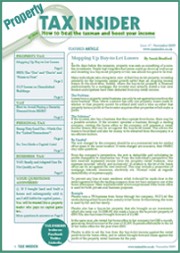Landlords of residential property suffer from a disadvantage when it comes to claiming capital allowances on the cost of plant and machinery. Plant in a ‘dwelling house’ does not qualify for capital allowances. It is, however, still possible to claim capital allowances on plant installed in common areas.
By ‘common areas’ I mean, for example, a block of flats. Commercial landlords suffer from no such restrictions and can claim capital allowances on the cost of any plant and machinery they install.
The rates of capital allowances vary according to the nature of the plant involved. The default position is that plant qualifies for a ‘writing down allowance’ at a rate of 20% per year – which will reduce to 18% from April 2012, but certain items which are ‘integral’ to a building only qualify for a lower rate of 10% - reducing to 8% from April 2012.
‘Integral’ plant is defined by a list of items:
• Electrical Systems
• Cold water systems
• Systems for heating, ventilation, hot water, and air conditioning
• Lifts, escalators, and mechanical walkways
• External solar shading
Annual Investment Allowance (AIA)
All of the above types of plant, however, qualify for the Annual Investment Allowance (AIA), which gives tax relief for 100% of expenditure on plant and machinery up to a limit of £100,000 for the year. This limit is also being reduced in April 2012, to a mere £25,000, so if you were thinking of spending some money on plant in your building, now is the time.
A word of warning to limited companies – if your accounting period does not end on 31 March, you need to take advice to see how the transitional rules affect your entitlement to the AIA – your allowance will be less than £100,000 for the accounting period which straddles 31 March 2012 and exactly when you incur the expenditure will be important.
The majority of plant installed in a building is likely to be ’integral‘ as defined above, but with a £100,000 AIA for the current tax year, in many cases the expenditure will be covered by the AIA and will never be subject to the lower rate of writing down allowance.
More to Claim!
It is not only the cost of the actual plant that can be claimed. The costs of transporting the plant to your building, and of installing it, are considered part of the cost of the plant, and can thus qualify for the AIA.
You can also claim the cost of alterations to an existing building which are done for the purpose of installing plant and machinery. For example, if it is decided to install a lift in a building, the cost of constructing the lift shaft - including the bricks and mortar – can be treated as part of the cost of the lift itself, and thus will qualify for the AIA.
Note that this only applies to the cost of altering an existing building, not constructing a new one. Where the installation of plant and machinery involves an extension to an existing building, you will need to be able to satisfy the taxman that the alterations were ‘incidental’ to the installation of the plant and machinery.
What Does This Mean?
‘Incidental’ has been defined by the Courts to mean that the alterations were required in order to install the plant. It is not enough to show that the extension was needed to provide sufficient room to put the plant – there must be a clear connection between the building cost and the installation of the plant itself.
Practical Tip
It is important to liaise with your architect, builder, and quantity surveyor to ensure that all such expenditure is identified, and where possible, the plans and the invoices should indicate those works that were ‘incidental’ to the installation. An appropriate proportion of these professionals’ fees can also be treated as part of the cost of the plant.
 Landlords of residential property suffer from a disadvantage when it comes to claiming capital allowances on the cost of plant and machinery. Plant in a ‘dwelling house’ does not qualify for capital allowances. It is, however, still possible to claim capital allowances on plant installed in common areas.
Landlords of residential property suffer from a disadvantage when it comes to claiming capital allowances on the cost of plant and machinery. Plant in a ‘dwelling house’ does not qualify for capital allowances. It is, however, still possible to claim capital allowances on plant installed in common areas.

 Tax Articles
Tax Articles